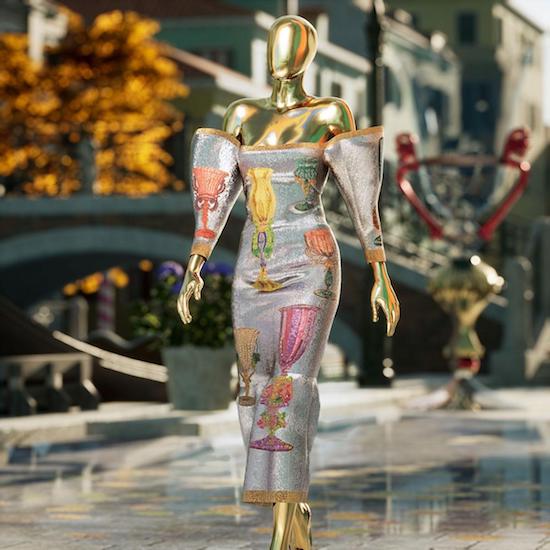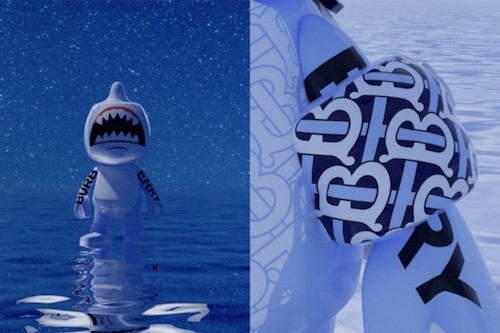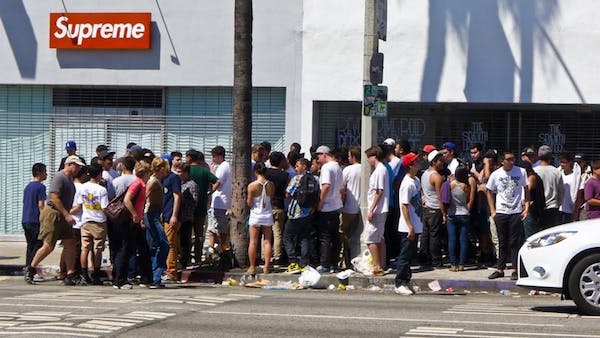
There was a time when buying fashion was solely an investment in yourself. You bought fashion, at varying price points, thinking little or nothing of its intrinsic value after you’d finished using or wearing it. If it was lucky it would make a few pounds at a local charity shop after being donated. It was only very special showpieces or clothing worn by famous people that held any real value.
Left - Dolce & Gabbana sold its last Alta Moda Couture collection in NFT format
Today, designer fashion is being spun as ‘Contemporary Vintage’ or ‘Future Vintage’. It is being sold on the promise that it will retain some type of value or even increase. A generation of younger people are being asked to pay increasing prices for trainers and clothes on the pretence that they are an astute investment. Sounding like a giant Ponzi scheme, and adding in things like NFTs, are we seeing a new generation being hoodwinked into ‘investing’ into fashion?
“I think it's a complex landscape here, almost half of the UK Generation Z saw some negative alteration to their employment through the pandemic period, and for this generation, it's increasingly hard to get into meaningful work.” says Petah Marian, founder of Future Narrative, a retail, culture and consumer trends expert.
“This sense that the system is rigged against them is leading to all sorts of speculative behaviours, be it trying to get access to limited-edition trainers to flip, or in some cases crypto currencies. Some people do make considerable amounts of money out of selling items, but, unless you know what's going to hold value, it's a risky game, as a lot of the future value lies in how well it will resonate later on.” she says.
In November, London designer fashion retailer, Machine-A, with self-described 'contemporary vintage’ e-commerce site Byronesque, launched a vintage area selling archival and rare runway pieces from the like of Rick Owens and Raf Simons.
“As I understand it, contemporary vintage is just a new way of marketing vintage items. The way that Machine B is positioning itself is that the contemporary vintage selection will be key vintage items from a series of iconic designers that have a certain cult appeal.” says Marian.
Called Machine-B, it launched at the Machine-A store in Soho and online. What was interesting was how Machine-A was using these archival pieces to promote its other contemporary designer offering and labelling it as ‘future vintage’. This speculative retail approach included small and lesser known brands such as Stefan Cooke and Kiki Kostadinov.
Kerry Taylor, founder of Kerry Taylor Auctions, the world's leading auction house specialising in vintage fashion, fine antique costume and textiles, says, “I have concerns about people purchasing trainers for hundreds of thousands of dollars – when we know that items made from rubber or plastics in the 1960s have started to revert/disintegrate. High quality artisanal items such as Hermès handbags however are probably only going to increase.” she says. “I would trust vintage vintage as it has an established track record rather than ‘contemporary vintage’ which is a bit of a contradiction in terms. We have no idea of the marketing hype will come true.” says Taylor.
Taylor thinks brands and designers are marketing their clothes and product like this to make them seem more special in a world flooded with brands and garments. If you were to ‘invest’, what would you look for?
“They should buy what they like rather than just for an investment. Investments can go up or down – but if you love a piece – then it doesn’t matter so much. Always check condition – avoid anything altered or with damage.” says Taylor.
 Marian thinks brands that have a strong and passionate fan base or items that either speak to a brand's codes or are exceptional examples of where it departs from it are more shrewd investments, as well as items that have a limited release.
Marian thinks brands that have a strong and passionate fan base or items that either speak to a brand's codes or are exceptional examples of where it departs from it are more shrewd investments, as well as items that have a limited release.
“It's part of the broader narrative around circularity and retailers slowing consumption around new items, while also generating buzz around key designers by elevating second-hand items as "archive pieces" that are special and rare.” says Marian.
Right - Burberry's first NFT collection launched in August 2021
Fashion brands are offering other avenues to invest, and making their brands look more attractive in the process. NFTs or non-fungible tokens, offer a chance to buy digital versions of an item. Individuals need to establish a digital wallet to store your cryptocurrency in order to purchase an NFT.
In June, Gucci partnered with Christie’s selling an NFT video called ‘Aria’, the title of its AW21 collection, for $25,000, while in September, Dolce & Gabbana sold an NFT couture Alta Moda suit for £740,000 at auction. The new owner also got a physical suit for that price. Dolce & Gabbana grossed $5.7 million from its first auction of NFT collectibles.
Tying fashion items and collections to NFTs raises the investment levels, but are NFTs likely to be a good long-term investment?
“It's very early to say what the mass uptake will look like.” says Marian. “There's a passionate community of collectors that are driving up the value of NFTs at the moment, but I can't say what the long term value of the current releases of NFTs. I think NFTs are here for the longer term, but it's very early to say what the value or the market will look like for individual assets in a year or two years from now yet.” she says.
Add the growing noise around the Metaverse - the British Fashion Council (BFC) recently announced a brand new category as part of The Fashion Awards 2021—the first ever Fashion Award for Metaverse Design exclusively with Roblox - and the way digital and physical items are blurring, these new ways of owning or consuming as item are selling themselves as investment opportunities to a younger and more engaged consumer.
 All investments are speculative. By linking and promoting positive examples of fashion items increasing in or holding their value, brands are cleverly giving the illusion that it is a certain. This is targeted at the younger consumer queuing at stores in Soho or entering ballots for items happy to pay significant sums of money with the idea lurking in the background that they will be able to resell it at some point or even flip at a profit. Websites like Stock X continue to propel the hyped hysteria.
All investments are speculative. By linking and promoting positive examples of fashion items increasing in or holding their value, brands are cleverly giving the illusion that it is a certain. This is targeted at the younger consumer queuing at stores in Soho or entering ballots for items happy to pay significant sums of money with the idea lurking in the background that they will be able to resell it at some point or even flip at a profit. Websites like Stock X continue to propel the hyped hysteria.
Left - Hyped kids? Luxury brands are invested in giving the perception their goods will retain or even increase their value to younger, Gen Z consumers
Fashion has never really been a serious investment before. Fashion, in its nature, is fickle and unpredictable. Implying that something is resellable at a price close to what you paid for it and/or a solid investment is another pull brands are using to activate the purchasing power of their expensive products. It doesn’t feel like you’re chucking your money away like it did in the past to a generation more careful with money. This bubble is getting bigger and we all know what happens to bubbles when they get too big.
Buy TheChicGeek's latest book FashionWankers - HERE
Check out TheChicGeek's new shop of fabulous plants & books - Give me Penis Cactus!